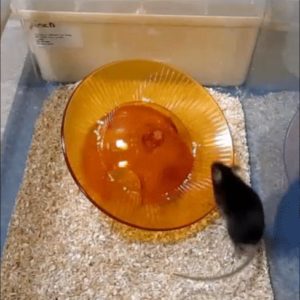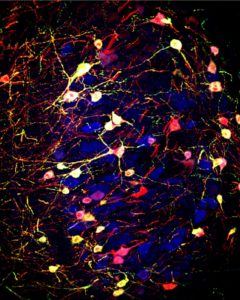Scientists at the University of California, San Diego (UCSD), have identified changes in how neurons in the brain behave that may explain the neurological basis by which physical exercise can improve our ability to learn new motor skills. Studies in mice by Hui-Quan Li, PhD, and Nicholas C. Spitzer, PhD, found that one week of voluntary wheel running induced a specific population of neurons in the animals’ brains to switch neurotransmitter expression from acetylcholine (ACh) to gamma-aminobutyric acid (GABA), and that this switch helped to boost their ability to learn a series of motor skills. Blocking this neurotransmitter switch inhibited the beneficial effects of running on the animals’ ability to learn the new skills.
“This study provides new insight into how we get good at things that require motor skills and provides information about how these skills are actually learned,” said Spitzer, the Atkinson Family Chair in the biological sciences section of neurobiology and a director of the Kavli Institute for Brain and Mind. The newly identified association between neurotransmitter switching and the beneficial effects of sustained running on motor skill learning could offer up a new target for treating movement disorders, the researchers suggested. “With an understanding of this mechanism comes the opportunity to manipulate and to harness it for further beneficial purposes,” Spitzer added. “In the injured or diseased individual, it could be a way of turning things around… to give the nervous system a further boost.”
Spitzer and Li reported their findings in Nature Communications, in a paper titled, “Exercise enhances motor skill learning by neurotransmitter switching in the adult midbrain.”
It’s well recognized that regular aerobic exercise, such as running, has wide-ranging health benefits on energy, mood, sleep, and motor skills, but what scientists haven’t understood is what neurological changes in the brain are triggered as a result of exercise to enable these improved states of health. “Aerobic physical exercise promotes the ability to acquire new motor skills and serves as a therapy for many motor disorders, but its basis of action is not well understood,” the authors commented.
The Spitzer lab has previously carried out research on the ability of neurons to change their transmitter identity in response to sustained stimuli, which typically leads to changes in behavior. After carrying out work that described neurotransmitter switching in depression, Spitzer and colleagues turned their attention to how such switching might be involved in healthy conditions. “We hypothesized that chronic running induces neurotransmitter switching in a circuit that is important for motor skill learning,” they wrote.
To look into this, the team turned to study mice, which will naturally run on a wheel. “Running is a natural motor activity for mice and generates plasticity in multiple brain regions,” the investigators continued. For the reported study, Li and Spitzer analyzed the brains of mice that were given wheels for voluntarily running for a week, with the brains of mice that had no access to running wheels. They found that the exercised group more rapidly acquired measurable motor skills such as staying on a rotating rod or crossing a balance beam compared with the non-exercised group.

Interestingly, the results showed that the transmitter switch reversed one week after running, even when training and testing on the rotorod and balance beam occurred immediately after running, although the acquired motor skills persisted for at least two weeks (but not for as long as four weeks). And if training on the rotarod and balance beam was delayed until a week after running ended, the animals didn’t demonstrate any enhanced motor learning skills compared with the control group of animals. “This result suggests that running creates a sensitive period in the adult brain during which motor skill learning is improved and shows that the gain in motor skills persists longer than the duration of this period.” This indicates that the transmitter switch is not necessary for maintaining the acquired motor skills.

Based on their findings, the researchers propose a model in which conversion of cPPN excitatory cholinergic neurons to inhibitory GABAergic neurons provides feedback control regulating motor coordination and skill learning. “Transmitter switching in the cPPN, particularly when it may change the sign of the synapse from excitatory to inhibitory, appears to rewire motor circuitry to enhance motor skills,” they concluded.
Of relevance, they stated, the PPN regulates many of the components, including balance, coordination, motivation, attention, and muscle strength, that are necessary for the acquisition of motor skills. “… transmitter switching in the cPPN may contribute to motor skill learning through regulating one, several, or even all of these aspects,” they suggested. “Our finding that transmitter switching after running is a critical event for improving motor skill learning suggests that transmitter switching may be important in many circumstances where sustained exercise benefits behavior.”
The researchers would like to test whether neurotransmitters could be deliberately switched to benefit motor skills, even without exercise, and they plan to conduct research on whether exercise similarly triggers benefits of motor skill learning in cases of neurological disorders.
“With an understanding of this mechanism comes the opportunity to manipulate and to harness it for further beneficial purposes,” Spitzer said. “In the injured or diseased individual, it could be a way of turning things around… to give the nervous system a further boost.”
Li said the results underscore the importance of exercise, even at home during the current SARS-CoV-2 pandemic quarantine situation. “This study shows that it’s good for the brain to add more plasticity. For people who would like to enhance their motor skill learning, it may be useful to do some exercise to promote this form of plasticity to benefit the brain. For example, if you hope to learn and enjoy challenging sports such as surfing or rock climbing when we’re no longer sheltering at home, it can be good to routinely run on a treadmill or maintain a yoga practice at home now.”



